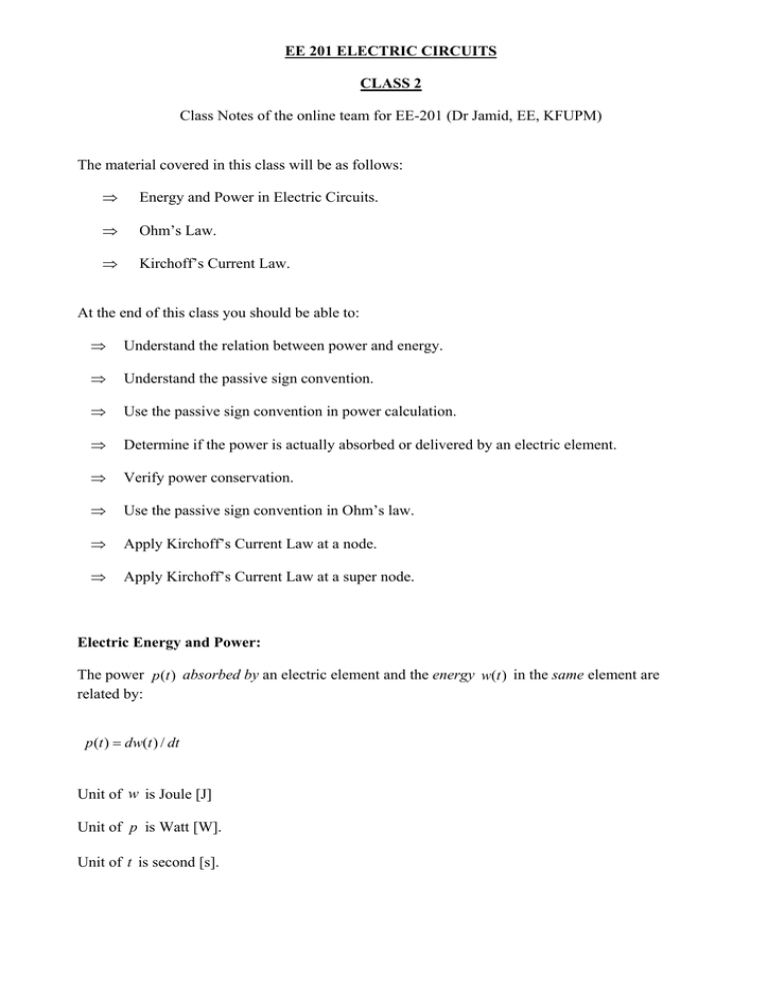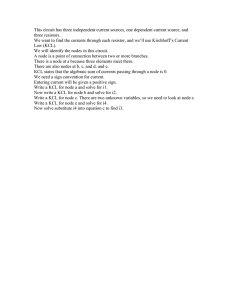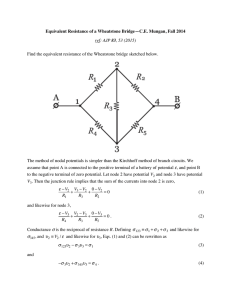Lec 02 WFig ver 01
advertisement

EE 201 ELECTRIC CIRCUITS CLASS 2 Class Notes of the online team for EE-201 (Dr Jamid, EE, KFUPM) The material covered in this class will be as follows: ⇒ Energy and Power in Electric Circuits. ⇒ Ohm’s Law. ⇒ Kirchoff’s Current Law. At the end of this class you should be able to: ⇒ Understand the relation between power and energy. ⇒ Understand the passive sign convention. ⇒ Use the passive sign convention in power calculation. ⇒ Determine if the power is actually absorbed or delivered by an electric element. ⇒ Verify power conservation. ⇒ Use the passive sign convention in Ohm’s law. ⇒ Apply Kirchoff’s Current Law at a node. ⇒ Apply Kirchoff’s Current Law at a super node. Electric Energy and Power: The power p (t ) absorbed by an electric element and the energy w(t ) in the same element are related by: p (t ) = dw(t ) / dt Unit of w is Joule [J] Unit of p is Watt [W]. Unit of t is second [s]. If the energy w(t ) increases with time [ w(t ) has a positive slope], then: dw(t ) / dt > 0 ⇒ p (t ) > 0 ⇒ power is being actually absorbed by the element If w(t ) decreases with time [ w(t ) has a negative slope], then: dw(t ) / dt < 0 ⇒ p (t ) < 0 ⇒ power is being actually delivered by the element w(t ) increases ⇔ power being absorbed decreases ⇔ power being delivered w(t ) The power p (t ) can be expressed in terms of i (t ) and v (t ) : p= dw dq = vi dq dt ⇒ p (t ) = v (t )i (t ) The above relation p = iv applies only when the current enters the element the (+) terminal and leaves the (-) terminal. a i(t) + Electric Element v(t) - b Figure 1 If the current enters the element the (-) terminal and leaves the (+) terminal, then we have: p = −iv In this case, it is necessary to insert a minus sign in the power expression, in order to have consistent results. Figure 2 Example 1: i) Calculate the power absorbed by each element in the given circuit. ii) State whether the power is actually absorbed or actually delivered by the element. Figure 3 Solution: a) p = +iv = + (5) × (10) = +50 W ⇒ p>0 ⇒ actually absorbed b) p = −iv = −(−4) × (3) = +12 W ⇒ p>0 ⇒ actually absorbed p<0 ⇒ actually delivered p<0 ⇒ actually delivered c) p = −iv = −(−12) × (−10) = −120 W d) p = +iv = + (60) × ( −6) = −360 W ⇒ The following statements are equivalent: Power absorbed by the element Power delivered to the element ⇒ Power dissipated by the element Power consumed by the element. The following statements are also equivalent: Power delivered by the element Power generated by the element. The symbol p will be reserved for the power absorbed by the element. Example 2: i) Calculate the power absorbed by each element in the given circuit. ii) Show that the total power dissipated equals to the total power generated. Ω Ω Figure 4 Solution: i) p6V = +iv = +(7 / 4)(6) = 10.5W ⇒ dissipated p3 A = −iv = −(3)(20) = −60W ⇒ generated p16 Ω = +iv = +(5 / 4)(20) = 25W ⇒ dissipated p8Ω = −iv = −(7 / 4)(−14) = 24.5W ⇒ dissipated ii) ∑p dis = 10.5 + 25 + 24.5 = 60W ∑p gen = 60W ∴ ∑ pdis = ∑ pgen = 60W Ohm’s law: The voltage v (t ) and the current i (t ) in a resistor R are related by: v = iR The above relation is valid only if i (t ) enters the (+) terminal and leaves the (-) terminal. Figure 5 If i (t ) enters the (-) terminal and leaves the (+) terminal, then Ohm’s law must be changed to: v = −iR + R v(t) i(t) Figure 6 The passive sign convention: The use of the ± signs in Ohm’s law and the power expression is known as the passive sign convention. i (t ) enters the (+) terminal ⇒ p = +iv & v = +iR ⇒ p = −iv & v = −iR i (t ) enters the (-) terminal Example 3: Calculate the unknown quantities in the following circuit. R 6 V 4 Ω = 2 -3 2V - V 16 Ω 8 Ω Figure 7 Solution: v1 = +(6)(2) = 12V v2 = −(6)(6) = −36V i3 = +(16) /(8) = 2 A R = −(v4 ) / i3 = −(−32) /(2) = 16Ω Kirchoff’s Current Law (KCL). The sum of currents entering a node is equal to the sum of currents leaving that node. i1 + i4 = i2 + i3 + i5 Equivalent statement of KCL: The algebraic sum of currents entering a node is equal to zero. i1 − i2 − i3 + i4 − i5 = 0 Figure 8 Example 4: Calculate the unknown currents in the following circuits. Ω Ω Ω Ω Ω Ω Ω Ω Ω Ω Figure 9 Solution: a) KCL at node (a) ⇒ i1 = 2 + 4 = 6 A b) KCL at node (a) ⇒ 3 + i1 = 1 ⇒ i1 = −2 A ⇒ 3 + i1 − 1 = 0 ⇒ i1 = −2 A ⇒ i1 − 4 + 2 = 0 ⇒ i1 = 2 A 0.5 − i2 − 2 = 0 ⇒ i2 = −1.5 A Alternatively KCL at node (a) c) KCL at node (b) KCL at node (c) ⇒ Check KCL at node (a) ⇒ −i1 + 4 + i2 − 0.5 = −(2) + 4 + (−1.5) − 0.5 = −4 + 4 = 0 KCL is also applicable to a closed area (super node). The algebraic sum of currents entering a super node is equal to zero. i1 + i2 − i3 + i4 − i5 = 0 Figure 10 Example: Calculate the currents i1 and i2 in the circuit shown below: Ω Ω Ω Ω Ω Ω Ω Ω Figure 11 Solution: KCL at super node 1 ⇒ 3 − i1 = 0 ⇒ i1 = 3 A KCL at super node 2 ⇒ i2 = 0 ⇒ i2 = 0 A Ω Ω Ω Ω Figure 12




